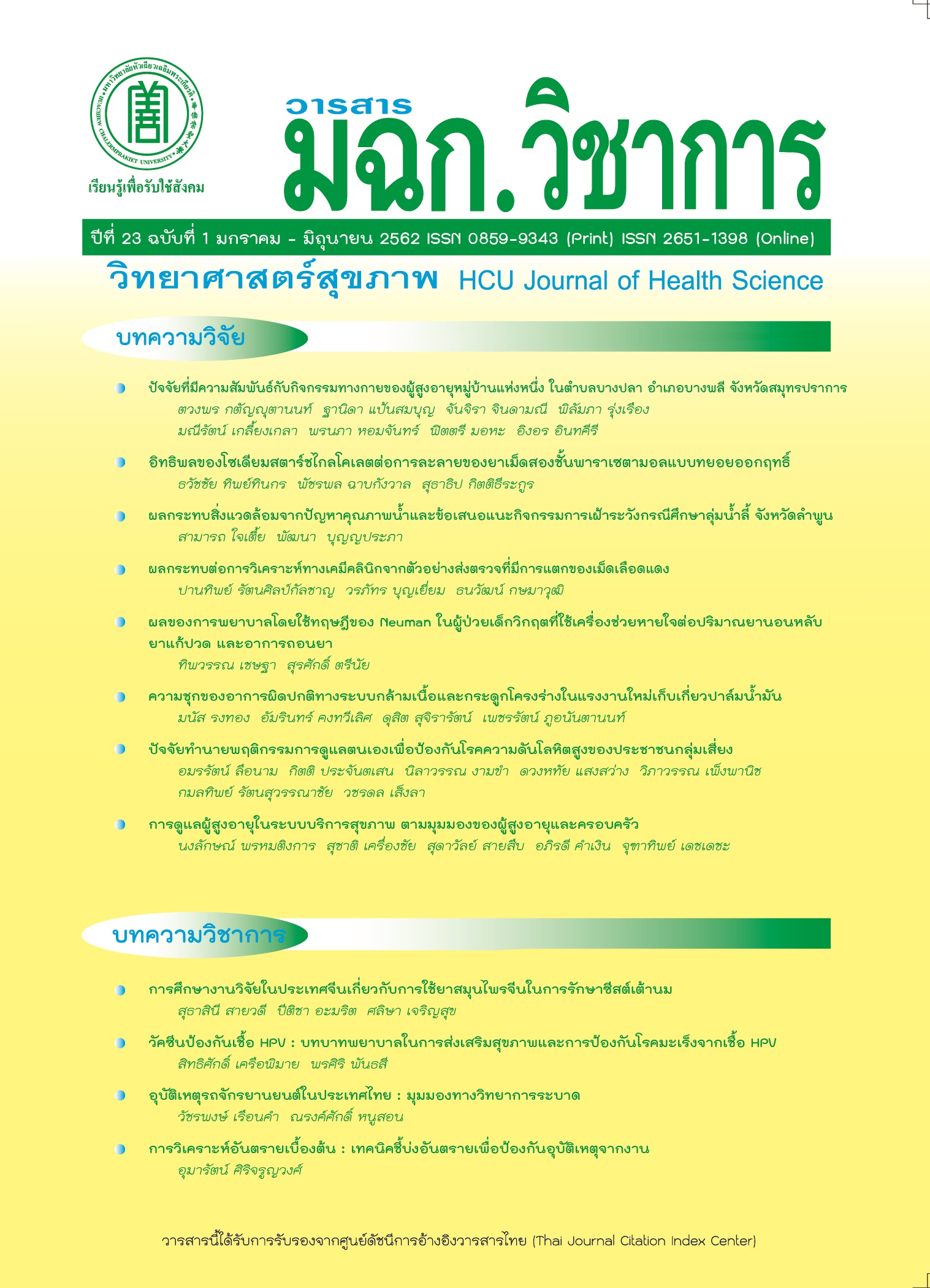Preliminary hazard Analysis (PHA): Hazard Identification Technique for Work Accident Prevention
Keywords:
Hazard identification technique, preliminary hazard analysis, work accidentAbstract
The Preliminary Hazard Analysis (PHA) technique is a tool used to search for basic hazards and used to search for hazards during the design of production processes or machines in order to set adequate safety measures before production starts. In addition, this technique is very useful for proactive safety management. The PHA technique has a complicated procedure that can use to investigate basic causes of accidents. The implementation of PHA has a total of 6 steps, including analyzing scope determining, the risk level estimation criteria based on relevant factors, hazard analysis team, risk evaluation and eliminating or reducing risk. For the input for hazard identification this consists of data from manuals of concerned machinery, electrical systems, toxicity of chemicals, work instructions and past accident information, etc. The output part consists of issues of various mistakes of process units or machines, danger source and defects or inadequacy of safety measures. Hazardous findings must be registered on the Preliminary Hazard List (PHL) together with the risk level. Risk level should be determined based on the likelihood of occurrence and severity or other factors associated. Hazard identification with this technique leads to the initial system safety requirements (SSRs). However, this technique is only a Preliminary Hazard Analysis. For increasing capabilities, this technique should be used with other techniques such as failure mode effects analysis (FMEA) or what-if.
Downloads
References
2. อุมารัตน์ ศิริจรูญวงศ์, พงษ์สิทธิ์ บุญรักษา. การวิเคราะห์หาสาเหตุของการประสบอันตรายขั้นหยุดงานเกิน 3 วัน ด้วยเทคนิคการวิเคราะห์ต้นไม้แห่งความล้มเหลว: กรณีศึกษา 17 โรงงานอุตสาหกรรมในจังหวัดสมุทรปราการ. วารสารความปลอดภัยและสุขภาพ. 2561;11(1):1-14.
3. Rausand M. Risk assessment: theory, methods, and applications. New Jersey: John Wiley & Sons; 2013.
5. Manuele FA. Risk assessments: their significance and the role of the safety professional. New Jersey: John Wiley and Sons; 2016.
6. Popov G, Lyon BK, Hollcroft B. Preliminary hazard analysis. In: Popov G, Lyon BK. Risk assessment: a practiced guide to assessing operational. New Jersey; John Wiley and Sons; 2016. p.145-62.
7. Clifton AE. Preliminary hazard analysis In: Ericson CA. Hazard Analysis Techniques for system safety. New Jersey: John Wiley and Sons; 2005.
8. Anibal L, Taboas A, Alan M, Thomas SL. Chapter 6.4 Hazard Identification. In: Anibal L, Taboas A, Alan M, Thomas S.L. The Decommissioning Handbook. New York: ASME Press; 2004. pp.339.
9. กระทรวงอุตสาหกรรม กรมโรงงานอุตสาหกรรม. ระเบียบกรมโรงงานอุตสาหกรรมว่าด้วยหลักเกณฑ์การชี้บ่งอันตราย การประเมินความเสี่ยงและการจัดทำแผนงานบริหารจัดการความเสี่ยง พ.ศ. 2543. กรุงเทพมหานคร: กรม กระทรวง; 2543.
10. การนิคมอุตสาหกรรมแห่งประเทศไทย. ข้อบังคับคณะกรรมการการนิคมอุตสาหกรรมแห่งประเทศไทย ว่าด้วยหลักเกณฑ์ วิธีการ และเงื่อนไขในการประกอบกิจการในนิคมอุตสาหกรรม (ฉบับที่ 4) พ.ศ. 2559. ราชกิจจานุเบกษา. 2559;133 (ตอนพิเศษ 111 ง): น.17-32.
11. American Institute of Chemical Engineering. Overview of hazard evaluation techniques In: Des Plain IL. Guidelines for hazard evaluation procedure. 2nded. New York: Center for Chemical Process Safety; 1992. pp.460.
12. ILO/UNEP/WHO International Programme on Chemical Safety. The role of management. Major hazard control: a practical manual. 3thed. Geneva Switzerland: International Labour Office; 1993: p.12.
13. Reese CD. Hazard assessment. Reese CD. Occupational health and safety management: a practical approach. New York: A CRC: 2003.
14. กระทรวงอุตสาหกรรม. ประกาศกระทรวงอุตสาหกรรม เรื่อง การปองกันและระงับอัคคีภัยในโรงงาน พ.ศ. 2552. ราชกิจจานุเบกษา. 2552; 126 (ตอนพิเศษ 143 ง): น.23-28.
15. Louvar JF, Louvar BD. Hazard identification. Health environmental risk analysis: foundational with applications. New Jersey: Prentice-Hall; 1998.
16. บริษัท คอนซัลแทนท์ ออฟ เทคโนโลยี จำกัด. เอกสารรายงานการประเมินความเสี่ยงทางด้านอาชีวอนามัยและความปลอดภัยของโรงงานผลิตสังกะสีออกไซด์และผลิตภัณฑ์เคมีสำหรับยางอุตสาหกรรมแห่งหนึ่ง อำเภอปลวกแดง จังหวัดระยอง. กรุงเทพ: ซีโอที จำกัด; 2560.
Downloads
Published
How to Cite
Issue
Section
License
บทความที่ได้รับการตีพิมพ์เป็นลิขสิทธิ์ของวารสารวิทยาศาสตร์สุขภาพและสุขภาวะ
ข้อความที่ปรากฏในบทความแต่ละเรื่องในวารสารวิชาการเล่มนี้เป็นความคิดเห็นส่วนตัวของผู้เขียนแต่ละท่านไม่เกี่ยวข้องกับมหาวิทยาลัยหัวเฉียวเฉลิมพระเกียรติ และคณาจารย์ท่านอื่นๆในมหาวิทยาลัยฯ แต่อย่างใด ความรับผิดชอบองค์ประกอบทั้งหมดของบทความแต่ละเรื่องเป็นของผู้เขียนแต่ละท่าน หากมีความผิดพลาดใดๆ ผู้เขียนแต่ละท่านจะรับผิดชอบบทความของตนเองแต่ผู้เดียว




